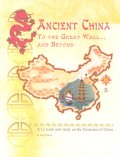It's a bit daunting to realize that most of us know next to nothing about China, the country that has the greatest percentage of the world's population. Most history textbooks give scant attention to China as they catalog their way through "major world civilizations." Given China's increasingly important role in the world economy and political scene, we would do well to ensure that our children know more than we do regarding China.
Judy Wilcox has put together a fascinating and fun 12-week unit study on China. Although she has written with children in grades K through 6 in mind, Judy has included resource recommendations for all ages in the extensive annotated bibliography plus a seven-page "Grades 7-12 Supplement" in an appendix that provides specific activities and assignments for older students. By assigning reading and research from such resources, all ages can study China together.
Consider this a "limited" unit study—it primarily covers history even though it is a multi-sensory study that includes geography, language arts, science, critical thinking, religion, fine arts, crafts and other activities. With younger students a science or art topic or activity might well be sufficient for that subject area for the day or week, but none of these other subject areas is covered comprehensively. In addition, you will need to choose from the wealth of options those that are most practical and useful for your children. While it might be possible to skip many of the time consuming activities and complete the study in 8 to 10 weeks, I think you and your children will enjoy it much more if you make time for at least some of them.
There is much to like about this book. It works through Chinese history in chronological order, even providing timeline figures in an appendix at the back. So it's not just a "cultural" study of China that teaches about the abacus, gunpowder, and Confucius out of context. It includes some study of religious beliefs, frequently directing students to research or consider biblical contrasts. Judy sometimes relates historical events in China to the biblical timeline for context.
While a great deal of information is included within this book, you will definitely need to borrow or buy additional resource books as you do with most unit studies. Daily lesson plans provide some background information usually followed by a suggested reference or video for more information. Depending upon the topic, there might be one or more activity suggestions which range from constructing terra cotta soldiers or a model Qin house to handling silk or bronze to understand what they feel like. Lesson plans differ dramatically from day to day. You will definitely need to plan ahead to have resources on hand as needed.
Reading remains a major part of this unit study, plus older students should each keep a notebook where they record key ideas from their own reading or from discussions.
In addition to the supplement, bibliography, and timeline figures, the appendices include a culminating quiz, a crossword puzzle that will test students' knowledge, a glossary, two reproducible maps, and an index. This last item is a pleasant surprise that I very much appreciate in this sort of study but rarely find.










